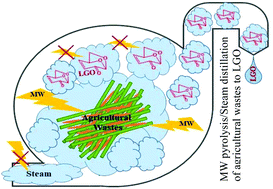Combining steam distillation with microwave-assisted pyrolysis to maximise direct production of levoglucosenone from agricultural wastes†
Abstract
The favourable impact of using a wet waste stream of agricultural residues in a biorefinery was studied through a combination of pyrolysis and self-induced steam distillation of hemicellulose depleted barley straw. The results showed that steam distillation provided both selective isolation and higher yields of polysaccharide-derived products such as levoglucosenone (LGO). The acid content of pretreated barley straw had the highest impact on the products selectivity. Both hydrolytic and pyrolytic pathways contributed to the products distribution, with higher selectivity toward pyrolytic products such as levoglucosan and LGO when less than 0.8 wt% acid was used. Interestingly, the increase of water content increased the overall products yields but had no impact on the products selectivity suggesting that the water did not directly impact on the decomposition pathway. In situ vaporisation of the water generates a microwave transparent steam environment preventing the distilled products for further degradation. The observation of the selective microwave activation of the polysaccharides in the presence of lignin offers significant opportunities for subsequent conversion of lignocellulosic biomass.

- This article is part of the themed collection: Green Biorefinery Technologies based on Waste Biomass


 Please wait while we load your content...
Please wait while we load your content...